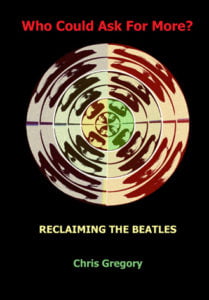
WHO COULD ASK FOR MORE: RECLAIMING THE BEATLES
…When asked by a journalist whether the group intended writing any anti-war songs, John – without a moment’s hesitation – replied tartly that ALL their songs were anti-war songs. These songs articulated both the immense fear that lay just beneath the surface of the supposedly carefree times they were living through and the ecstatic conflagration of sexual hysteria and primal, pagan consciousness that characterised those times; nowhere more so, perhaps, than in the final resonating chord of Sgt. Pepper’s A Day In The Life which fuses orgasm, the annihilation of the ego in the LSD experience and the ultimate, unspeakable cataclysm of the Bomb itself in one explosive moment…
Who Could Ask For More? is both an in-depth study of The Beatles’ songs and an often oblique commentary on their life and times. Identifying the constant fear of an imminent nuclear holocaust as the spark for the huge social changes of the decade, I have sought to ‘reclaim’ The Beatles from the tendency to position them within a fake ‘sixties nostalgia’ industry. He emphasises that their music represents …the quintessential expression of the sexual, social and cultural revolutions of the 1960s… and that it constitutes …a coherent act of resistance against the paranoid, repressed, ‘uptight’ culture they had grown up in…Combining analysis of their words and music with fictionalised sequences depicting key episodes in their career, the book provides a unique insight into an artistic and cultural phenomenon whose effects still resonate strongly many decades after the group broke up. The extraordinary evolution of their art is discussed in relation to the musical context of their day, with particular emphasis on the influence of 50s rock and roll and 60s soul music.
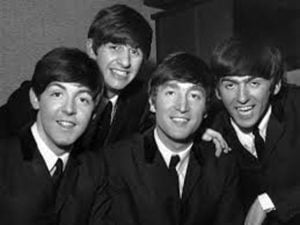
The book shows how The Beatles hit upon a world-conquering musical ‘formula’ which offered an ecstatic release for the dormant repressed sexuality of the early 60s, how their encounter with Bob Dylan was the catalyst for their swift  metamorphosis from ‘teen idols’ to ‘countercultural icons’ and how they reinvented notions of what rock music could achieve in a series of classic albums from Rubber Soul (1965) to Abbey Road (1969). The significance of their encounters with drugs and religion is considered in detail, as is the way they handled both the media and their own huge, unprecedented level of celebrity. There are discussions of their most complex and brilliant songs such as Yesterday, Nowhere Man, Eleanor Rigby, Strawberry Fields Forever, A Day In The Life, I Am The Walrus, Happiness Is A Warm Gun and Hey Jude, demonstrating how they learned to express their newly awakened poetic sensibilties within an astonishingly wide range of musical styles, creating work which expressed with great potency the key social, political and psychological concerns of the day. Even a song as apparently ‘innocent’ as Paul’s When I’m Sixty Four is shown to have a subtle subversive meaning in the context of the commentary on the tragic defects of the ‘straight world’ which forms the main theme of the group’s masterpiece Sgt. Pepper’s Lonely Hearts Club Band. As the author writes, …The Beatles’ best music seduces listeners with its sensual qualities and ravishes them with its potent, inexhaustible energy, while challenging them to see the world with new, unblinkered eyes…
metamorphosis from ‘teen idols’ to ‘countercultural icons’ and how they reinvented notions of what rock music could achieve in a series of classic albums from Rubber Soul (1965) to Abbey Road (1969). The significance of their encounters with drugs and religion is considered in detail, as is the way they handled both the media and their own huge, unprecedented level of celebrity. There are discussions of their most complex and brilliant songs such as Yesterday, Nowhere Man, Eleanor Rigby, Strawberry Fields Forever, A Day In The Life, I Am The Walrus, Happiness Is A Warm Gun and Hey Jude, demonstrating how they learned to express their newly awakened poetic sensibilties within an astonishingly wide range of musical styles, creating work which expressed with great potency the key social, political and psychological concerns of the day. Even a song as apparently ‘innocent’ as Paul’s When I’m Sixty Four is shown to have a subtle subversive meaning in the context of the commentary on the tragic defects of the ‘straight world’ which forms the main theme of the group’s masterpiece Sgt. Pepper’s Lonely Hearts Club Band. As the author writes, …The Beatles’ best music seduces listeners with its sensual qualities and ravishes them with its potent, inexhaustible energy, while challenging them to see the world with new, unblinkered eyes…
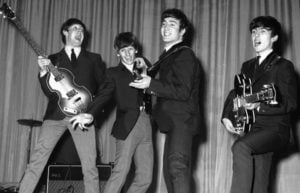
CHAPTER ONE: EVERYTHING THAT YOU WANT
This chapter outlines the influence of the major figures of ‘50s rock’n’roll on The Beatles, including Elvis, Chuck Berry and Little Richard. It also explains how The Beatles fused these influences with their love of the harmonic techniques of contemporary soul music to create the ‘ecstatic’ style of their early singles which made them world famous. I’ve also speculated as to exactly why this ‘ecstatic’ style appealed so much to teenage girls, and why The Beatles’ early style so potently symbolises the sexual revolution of the 1960s…
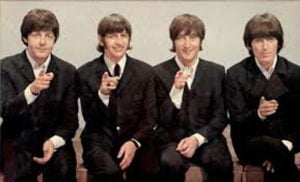
CHAPTER TWO: NO TIME FOR TRIVIALITIES
Here I’ve dealt with The Beatles’ transitional phase in the HARD DAYS’ NIGHT,  BEATLES FOR SALE and HELP albums, giving particular attention to how their encounter with Bob Dylan (and those funny cigarettes he passed them!) jumpstarted the group onto a bumpy but often inspirational journey from pop stardom to contemporary artistry. Other inspirations such as the soul music from the Stax label are also discussed. And we hear how YESTERDAY emerged into Paul’s dream consciousness as ‘Scrambled Eggs’…
BEATLES FOR SALE and HELP albums, giving particular attention to how their encounter with Bob Dylan (and those funny cigarettes he passed them!) jumpstarted the group onto a bumpy but often inspirational journey from pop stardom to contemporary artistry. Other inspirations such as the soul music from the Stax label are also discussed. And we hear how YESTERDAY emerged into Paul’s dream consciousness as ‘Scrambled Eggs’…

CHAPTER THREE: JUST A STATE OF MIND
This section includes an in depth look at the seminal RUBBER SOUL and REVOLVER albums, discusses the influence of LSD on the group’s collective psyche and explains how George Martin dealt with John’s request to get hundreds of chanting Tibetan monks into the studio. I’ve examined how the group became increasingly concerned with becoming ‘studio artists’ concerned with tailoring each song’s production and arrangement appropriately. Here we also see the effects of John’s infamous ‘Bigger Than Jesus’ speech, delivered ‘in his own words’…
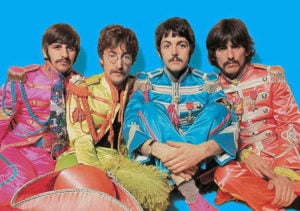
CHAPTER FOUR: NOTHING IS REAL
 The focus here is on the group’s meisterwerk SGT. PEPPER and attendant and subsequent single releases like STRAWBERRY FIELDS FOREVER, PENNY LANE and I AM THE WALRUS, which are examined in detail here. I’ve felt for some time that Sgt. Pepper has been critically misunderstood over the last few years. In my view it IS a concept album, focused on the 1960s generation gap. Beneath the bright surfaces of many of its songs lies a dark, scary conceit which stretches towards a kind of humble terror in the overwhelming finale of A DAY IN THE LIFE.Even the apparently harmless ‘When I’m Sixty Four’ harbours subversive undercurrents…
The focus here is on the group’s meisterwerk SGT. PEPPER and attendant and subsequent single releases like STRAWBERRY FIELDS FOREVER, PENNY LANE and I AM THE WALRUS, which are examined in detail here. I’ve felt for some time that Sgt. Pepper has been critically misunderstood over the last few years. In my view it IS a concept album, focused on the 1960s generation gap. Beneath the bright surfaces of many of its songs lies a dark, scary conceit which stretches towards a kind of humble terror in the overwhelming finale of A DAY IN THE LIFE.Even the apparently harmless ‘When I’m Sixty Four’ harbours subversive undercurrents…
CHAPTER FIVE: THE MOVEMENT YOU NEED
From HEY JUDE to THE WHITE ALBUM: The Beatles reinvent themselves yet again as everyband … singing songs and stories of ‘the great comedown’ with amazing virtuosity, from soppy ballads to silly reggae singalongs to screaming death blues to avant-garde dreamscapes. The effects of the group’s involvement with the Maharishi and transcendental meditation is also examined, especially with regard to its effect on songs like ACROSS THE UNIVERSE and SEXY SADIE. I’ve also looked at how many of their songs began to have increasingly autobiographical undercurrents, as tensions within the group began to rise.
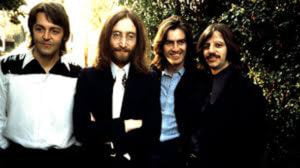
CHAPTER SIX: NOTHING YOU CAN DO THAT CAN’T BE DONE
1969…the final burn-out. The Beatles bow out in a storm of guitars, graceful  melodies and half-finished recordings. The attempt to get ‘back to basics’ that became the LET IT BE album and the final defiant tour-de-force of ABBEY ROAD are put under the microscope. We end with a ghostly reappearance…
melodies and half-finished recordings. The attempt to get ‘back to basics’ that became the LET IT BE album and the final defiant tour-de-force of ABBEY ROAD are put under the microscope. We end with a ghostly reappearance…



Leave a Reply